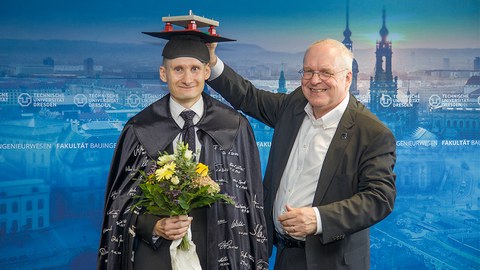Sep 09, 2024
Promotion Franz Bracklow

Prof. Dr. Manfred Curbach presents Franz Bracklow with his doctoral cap
On 05.09.2024, Dipl.-Ing. (FH) Franz Bracklow successfully defended his doctoral thesis on the topic of "Reinforced concrete plates underimpact loading and mineral-bonded
strengthening layer quantification". In addition to the chairman of the doctoral committee, Prof. Dr. Alexander Zeißler (TU Dresden), Prof. Dr.-Ing. Dr.-Ing. E.h. Manfred Curbach (TU Dresden) and Prof. Dr. Thomas Braml (Universität der Bundeswehr München) were present as reviewers. Prof. Eric Jacques (Virginia Polytechnic Institute and State University) was connected online.
Abstract:
Due to its good material properties and versatility, reinforced concrete (RC) is generally considered to be the building material of the 21st century. While the static mode of action has been extensively investigated, there are still open questions regarding the material and structural behavior under impact loading, e.g. due to rockfall, ship, vehicle or aircraft impact. For example, various impact experiments documented in the literature at the structural level show that the use of shear reinforcement leads to different results, while denser flexural reinforcement or, in particular, increased plate thicknesses show consistently positive tendencies. All these parameters have in common that they can only be influenced during the construction process and that subsequent adjustments, e.g. of the component geometry or the internal reinforcement, are only possible to a limited extent to increased requirements. In times of necessary material conservation, concepts for the subsequent strengthening of existing structures are becoming increasingly important. One possibility for retrofitting is the application of mineral-bonded
layers of textile-reinforced concrete (TRC) or carbon-reinforced concrete (CRC), the effect of which has already been quantitatively confirmed under impact.
Based on the initial situation described above, the objective of the present work is to investigate the influences of different reinforcement conditions and rear side strengthening layers on the impact behavior of RC plates. For this purpose, an experimental parameter study was carried out as part of a coherent test program within the drop tower facility of the Otto Mohr Laboratory (OML) of the Institute of Concrete Structures (IMB) at Dresden University of Technology (TUD). A total of 37 impact tests were performed in eight different specimen configurations, the individual structural behavior was quantified by means of so-called resistance spectrums, and the plate damage as well as the inner fracture body were analyzed. Additional repeatability impact tests and static experiments were realized to evaluate the reproducibility of the results obtained and to derive the quasi-static load-bearing capacity. It has been shown that the application of a strengthening layer on the rear side increases the perforation and especially the scabbing behavior under impact loading, while the magnitude of the rise depends on the internal reinforcement condition. However, the load increase potential under quasi-static
loading could not be fully exploited due to the intensive localization of the damage.
As part of a final empirical evaluation, existing estimation formulas for assessing the structural behavior of RC plates under impact loading were analyzed. A selected approach was used as the basis for adapting the formulas to the results obtained for the specimens with an additional strengthening layer. In the context of a subsequent recalculation and prediction of the scabbing and perforation behavior of further experiments with and without a strengthening layer, the developed approach was validated and a starting point for further experimental investigations was developed.
We would like to congratulate Franz Bracklow on completing his doctorate and wish him all the best and every success in his future endeavors.
